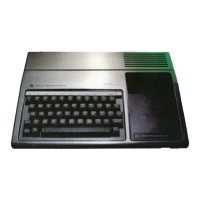Accuracy
Information
Radix·IOO
exponents
range
in
value from
-64
to
+63
which yield decimal values of
10-
128
to
10+1~6.
The
Radix-IOO
mantissa
and
exponent
combine to provide
an
equivalent decimal
range
of from
-9.9999999999999£127
through
-1.0000000000000£
-128:
zero: and
then
+
1.0000000000000£
-128
on through
+9.9999999999999£127.
2.
The
fraction 0.5
111
is
represented
as:
3F
32
00 00
00
00
00
00
3.a)
The
value of 11/2
is
represented
as:
40
01
39
07
60
20
43
SF
b)
The
value of -1T12 is:
BF
FF
39
07
60
20
43
SF
III-13
The
internal format
of
each
numerical value
consists of eight bytes.
The
first byte contains
the exponent
and
Its SIgn. bIased
by
40
hex.
The
remaining
bytes contain
the
mantissa.
with the
most significant digit first.
The
number
is
normalized so
that
the
deCImal point
is
immediately after the most significant digit.
If
the
number
is
negative, then the first two bytes
are
complemented.
Examples:
1.
The
number
127
10
is
represented as:
calculated
result to
be
equal to
another
value,
precautions
should
be
taken
to
prevcnt
improper evaluation.
For
the
above
example,
the
statement
X =
1£
-1
O*(INT(X
*1£10))
will
truncate
the
undlsfJlayeu
uigit::.i
uf
the
variaule
X
leaving only the
rounded
display value for
further use.
Technical Information on Number
Representation
Technically
speaking,
your
computer
U5C5
a
7-digit Radix-I
00
mantissa
for internal
calculations. A single Radix-I
00
digit has a
runge
of
value
from 0
to
99
in
base-} 0
arithmetic.
This
means
that
a 7-digit Radix-I 00
number
will
correspond
to decimal precision
of
13
to
14
digits.
depending
on
the
value.
LSD
00
00
00
00
EXP
MSD
41 01
IB
00
User's
Reference
Guide
The
final
result
indicate~
0.
discrepancy
in
the
fourteenth digit.
The
above fact is especially
important
when
writing your own programs. When testing a
X
=~/I
-1/1_1/1
PRINT
X
1£-14
The
higher
order
mathematical
functions use
iterative
and
polynomial calculations.
The
cumulative
rounding
error
is usually maintained
below
the
1a-digit display
so
that
no effect can
be seen.
The
13-digit
representation
of
a
number
is
three
orders
of
magnitude
from
the
displayed tenth digit. In this way
the
display
assures
that
results
are
rounded
accurately
to
ten digits.
Normally
thue
is nu
lleeu
tu even consider the
undisplayed digits.
On
certain
calculations,
as
with any
computer,
these digits
may
appear
as
an
answer
when
nut
expected.
The
mathematical
limits
of
a finite
operation
(word
length.
truncation
and
rounding
errors) do not
alluw
these
digits
to
always be completely
accurate.
Therefore.
when
subtracting
two
expressions which
are
mathematically
equal,
the
computer
may display a nonzero result.
Example:
Displayed Results Versus Accuracy
Computers,
like all
other
devices.
must
operate
with a fixed
set
of
rules within
preset
limits.
The
TI
computer
uses
especially powerful internal
notation to
represent
numbers.
The
mathematical
tolerance
of
the
computer
is
controlled by the
nUllIuer
uf digits it uses for
calculations.
The
computer
appears
to use
10
digits
as
shown
by
the
display, but actually uses
mUI
e
tu
lJel
funn
all calculatjons. When
rounded
for display
purposes,
these
extra
digits help
maintain
the
accuracy
of the values
presented.
Example:
III
x3
=.9999999999
(inaccurate)
The
example
shows
that
I!, = .3333333333,
when
multiplied by
3,
produces
an
inaccurate
answer.
However. a 13-digit
string
of
nines,
when
rounded
to
10
places, will
equal
1.0000000000.

